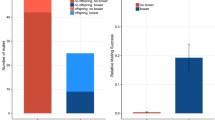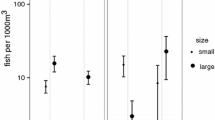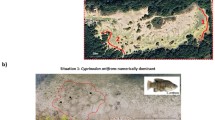Abstract
The spawning success of male rose bitterlings, Rhodeus ocellatus, adopting an alternative reproductive style, was estimated through behavioural data and electrophoretic paternal analyses in field observations and experiments. Three mating patterns were observed: territoriality, sneaking, and grouping. Mating patterns depended on a male's relative size and on local male density (the number of males around a spawning spot: a mussel). Spawning patterns (pair spawning, pair spawning with sneaker, and group spawning) varied with local male density. Time-budget data of the territorial males indicated a trade-off between chasing and courtship behaviour as local male density changed. Females deposited appoximately only 1 egg per egg-laying into the mussels. As a result of isozyme analysis, a minimum of 12% (two out of 17) of the offspring in the sample were found to have been fathered by sneaker males in pair spawning with sneaker. I scored through behavioural data the mating success per spawning for each pattern, on an individual basis. The average reproductive success per spawning for each pattern was: territorial (0.61), sneaking (0.31) and grouping (0.11), and thus the successes of the patterns were not equal. Accordingly, the alternative reproductive styles of male rose bitterlings are best interpreted as alternative phenotypes in a conditional behaviour.
Similar content being viewed by others
References cited
Borgia, G. 1980. Sexual competition in Scatophaga stercoraria: size-and density-related changes in male ability to capture females. Behaviour 75: 185-206.
Brockman, H.J., T. Conlson & W. Potts. 1994. Sperm competition in horseshoe crabs (Limulus polyhemus). Behav. Ecol. Sociobiol. 35: 153-160.
Chan, T.-Y. & A.J.R. Ribbink. 1990. Alternative reproductive behaviour in fishes with particular reference to Lepomis macrochira and Pseudocrenilaburs philander. Env. Biol. Fish. 28: 249-256.
Crespi, B.J. 1988. Alternative male mating tactics in a thrips: effects of sex ratio variation and body size. Amer. Midl. Nat. 119: 83-92.
De Boer, B.A. 1981. Influence of population density on the territorial, courting and spawning behaviour of male Chromis cyanea (Pomacentridae). Behaviour 77: 99-120.
Eadie, J.M. & J.M. Fryxell. 1992. Density dependence, frequency dependence, and alternative nesting strategies in goldeneyes. Amer. Nat. 140: 621-641.
Emlen, D.J. 1994. Environmental control of horn length dimorphism in the beetle Onthophagus acuminatus (Coleoptera: Scarabaeidae). Proc. R. Soc. London Ser. B 256: 131-136.
Gross, M.R. 1985. Disruptive selection for alternative life histories in salmon. Nature 313: 47-48.
Gross, M.R. 1996. Alternative reproductive strategies and tactics: diversity within sexes. Trends Ecol. Evol. 11: 92-98.
Hutchings, J.A. & R.A. Myers. 1988. Mating success of alternative maturation phenotypes in male Atlantic salmon, Salmo salar. Oecologia 75: 169-174.
Kanoh, Y. 1996. Pre-oviposition ejaculation in externally fertilizing fish: how sneaker male bitterlings contrive to mate. Ethology 102: 883-899.
Karino, K. & A. Nakazono. 1993. Reproductive behavior of the territorial herbivore Stegastes nigricans (Pisces: Pomacentridae) in relation to colony formation. J. Ethol. 11: 99-110.
Kodric-Brown, A. 1988. Effects of sex-ratio manipulation on territoriality and spawning success of male pupfish, Cyprinodon pecosensis. Anim. Behav. 36: 1136-1144.
Maekawa, K. & H. Onozato. 1986. Reproductive tactics and fertilization success of mature male Miyabe charr, Salvelinus malma miyabei. Env. Biol. Fish. 15: 119-129.
Mori, S. 1993. The breeding system of the three-spined stickleback, Gasterosteus aculeatus (forma leiura) with reference to spatial and temporal patterns of nesting activity. Behaviour 126: 97-124.
Nagata, Y. 1976. Reproductive behaviour of a bitterling, Rhodeus ocellatus (Kner). Physiol. Ecol. Japan 17: 85-90 (in Japanese).
Nagata, Y. 1985. The effect of social organization of the bitterling, Rhodeus ocellatus (Kner) and the condition of a bivalve, Anodonta woodiana Lea in a small pond on the number of fish eggs being laid in a bivalve. Mem. Osaka Kyoiku Univ., Ser. III 34: 9-26 (in Japanese).
Nagata, Y., T. Tetsukawa, T. Kobayashi & K. Numachi. 1996. Genetic markers distinguishing between the two subspecies of the rosy bitterling, Rhodeus ocellatus (Cyprinidae). Japan. J. Ichthyol. 43: 117-124.
Nakamura, M. 1969. Cyprinid fishes of Japan. Res. Inst. Nat. Resour. Spec. Publ. 4: 1-455 (in Japanese).
Philipp, D.P. & M.R. Gross. 1994. Genetic evidence for cuckoldry in bluegill Lepomis macrochirus. Mol. Ecol. 3: 563-569.
Radwan, J. 1993. The adaptive significance of male polymorphism in the acarid mite Caloglyhus berlesei. Behav. Ecol. Sociobiol. 33: 201-208.
Rico, C., U. Kuhnlein & G.J. FitzGerald. 1992. Male reproductive tactics in the threespine stickieback-an evaluation by DNA fingerprinting. Mol. Ecol. 1: 79-87.
Ryan, M.J., C.M. Pease & M.R. Morris. 1992. A genetic polymorphism in the swordtail Xiphophorus nigrensis: testing the prediction of equal fitnesses. Amer. Nat. 139: 21-31.
Shirai, K. 1962. Correlation between the growth of the ovipositor and ovarian condition in the bitterling, Rhodeus ocellatus. Bull. Fac. Fish. Hokkaido Univ. 13: 137-157.
Shuster, S.M. & M.L. Wade. 1991. Equal mating success among male reproductive strategies in a marine isopod. Nature 350: 608-610.
Taborsky, M. 1994. Sneakers, satellites, and helpers: parasitic and cooperative behavior in fish reproduction. Adv. Study Behav. 23: 1-100.
Ueda, T. 1979. Plasticity of the reproductive behaviour in a dragonfly, Sympertrum parvulum, Bartenoff, with reference to the social relationship of males and the density of territories. Res. Popul. Ecol. 21: 135-152.
Van Den Assem, J. 1967. Territory in the three-spined stickleback (Gasterosteus aculeatus), an experimental study in intraspecific competition. Behaviour, Suppl. 16: 1-164.
Warner, R.R. & S.G. Hoffman. 1980. Population density and the economics of territorial defense in a coral reef fish. Ecology 61: 772-780.
Warner, R.R. & P. Lejeune. 1985. Sex change limited by paternal care: a test using four Mediterranean labrid fishes, genus Symphodus. Mar. Biol. 87: 89-99.
Warner, R.R., D.R. Robertson & E.G.J. Leigh. 1975. Sex change and sexual selection. Science 190: 633-638.
Wiepkema, P.R. 1961. An ethological analysis of the reproductive behaviour of the bitterling (Rhodeus amarus Bloch). Arch. Neerl. Zool. 14: 103-199.
Author information
Authors and Affiliations
Rights and permissions
About this article
Cite this article
Kanoh, Y. Reproductive Success Associated with Territoriality, Sneaking, and Grouping in Male Rose Bitterlings, Rhodeus ocellatus (Pisces: Cyprinidae). Environmental Biology of Fishes 57, 143–154 (2000). https://doi.org/10.1023/A:1004585405848
Issue Date:
DOI: https://doi.org/10.1023/A:1004585405848




